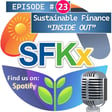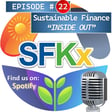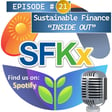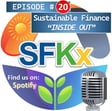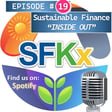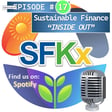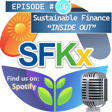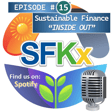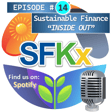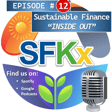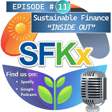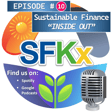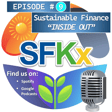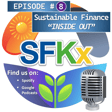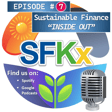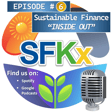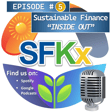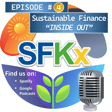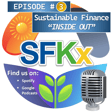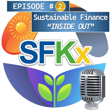Become a Creator today!Start creating today - Share your story with the world!
Start for free
00:00:00
00:00:01

Sustainable Finance Kx "Inside Out" Podcast Episode #13
Sustainable Finance Knowledge Exchange
We strive to bring you the critical news, events, major breakthroughs and key concepts covering the happenings in this super fast, evolving area of global finance – how the world funds the transition to Net Zero.
Think of us as a curator or sorts (much like a museum or gallery that curates the finest paintings and sculptures) as we source only the best educational knowledge around Sustainable Finance worth sharing.
Transcript
Introduction to Episode 13
00:00:16
Speaker
Hello and welcome to episode 13 already, can you believe it, of the Sustainable Finance KX Inside Out podcast. For those of you who are not overly familiar with us, we strive to bring you critical stories, events, major breakthroughs and key concepts covering the happenings in the super fast area of sustainable finance with an Asian twist and also some global perspective as well.
00:00:42
Speaker
We hope you like the podcast. Please check us out at www.sustainablefinancekx, one word.com, Twitter, or X, with the handle at Sust Finance, KX, S-U-S-T-F-I-N-A-N-C-E, KX, or LinkedIn Sustainable Finance, KX, and you can check us out on those socials.
00:01:07
Speaker
My name's SF DJ. No, I'm SF Guru. I always confuse that. SF DJ is still on holidays if you can believe it. So you're just with me SF Guru today and let's move right along with the latest news.
Green Bond Issuance Trends
00:01:23
Speaker
We saw a report from Moody's about green bond issuance bouncing again. Look, I think this November and December were really weak last year, January and February really strong. It's sort of evening out, and I think volumes on the bond market for the label is pretty much in line with last year. Let's see how second quarter goes. More pressure on the SLL market, which is a bit more
00:01:47
Speaker
a bit more cyclical. Within that, what is noticeable is the continuing issuance, huge volumes of sovereigns and supernaturals and also emerging markets are really on fire, so to speak, in terms of issuance volumes there. Southeast Asia growing along pretty well. So probably overall Europe, pretty stable. Asia growing and picking up the whole or the reduced volumes over there in the States.
00:02:17
Speaker
A little bit of action on the Sukuk market, which is exceeding now for ESG Sukuk's 50 billion, which is good to see. The more diversification, the more options, the more products, the more labels, I think generally good for issuers and for the market.
Challenges in Sustainable Finance
00:02:33
Speaker
We just wanted to draw this month's episode a little bit of attention to a few good reports that we saw recently. This one's about SLLs by Herbert Freehill's law firm.
00:02:46
Speaker
SLLs fall considerably down ahead of certain happenings. This year, we know that they've powered ahead in recent years. They were down about 40% last year. Concerns, I think, more about greenwashing, some cyclicality. I'll just read a couple of headlines from this report. Companies are just getting on with it. Financing does not change.
00:03:09
Speaker
whether they do SG or not. Our SG guy looked 20 years older than he did due to all the regulations. Investors want to clear sustainability narrative. We intended to have a sustainability link bank loan, but the administrative burden was too much. We need to balance adding more complexity with our funding arrangements with the financial effect. So again,
00:03:27
Speaker
It's a little bit of pressure creeping back on that in terms of decisioning and markets and greenwashing and what's the best thing to do. So let's keep an eye on that. Another report that I saw, which I really liked again from a law firm.
00:03:43
Speaker
slash consultancy Ropes and Gray. There were 10 points that they said to look out for in the sustainable finance sustainability space for 2024. So let's just whip through those. Some of these will be common as to issues that have been covered in the podcast before. Number one, SLB or linked bonds targets in the Paris Agreement. Coverage of scope three is still topical.
00:04:05
Speaker
highlights the need to cover more scope 3 in many of those scope of targets. New pricing model for SLBs. Again, the Anthropocene Institute having come out with an updated linked bond done handbook, talking about the different ways to do that, the Gramiums, the embedded option. Some of that's a little bit too technical for mine, but I think we always need to bear in mind, is it set at the right level?
00:04:32
Speaker
What's the proportionality of the penalty versus a non penalty, et cetera, et cetera. Number three, we've talked about before Enel missed one of its targets. Again, I think that's fine. And I think a sign of ambitions. I don't know what all the hoover is in relation to that.
00:04:50
Speaker
hybrid instruments with same transition and blue bonds and mixing use of proceeds with linked we'll see selectively a little bit more for those given the difficulty in maintaining and setting up our frameworks and things for for those. Number six EUGBS or green bond standard again coming in to being in 2024 or later this year
00:05:14
Speaker
ESMA's Greenbron proposals, the European Securities Market Association aims to standardise registration requirements to developing a level playing field for cost for different applicants. Let's see how the standardisation of different regulations go in that regard.
00:05:32
Speaker
ongoing topic of SBTI science-based target initiative and carbon credits in relation to scope three targets and the various things coming out of that. So just follow that news closely. What have we got now? Number eight corporate sustainability due diligence directive CSDDD directive scope narrow to apply in a little large close and has used and loosened only
00:05:58
Speaker
A stance on materiality and other things basically loosened its impact there, but continue to see that. The more data, the more benchmarking, the more companies disclose the better for sustainable finance overall. Number nine,
00:06:13
Speaker
SEC's emissions reporting rules still ongoing there, the exact scope of those. And number 10, the political climate is a critical factor for ESG, given what's happening maybe in the US, EU a little bit more stable and some other markets with big subsidy type programs. Let's see how the political climate and geopolitics impacts
00:06:34
Speaker
sustainability going forward.
Reports on Energy Transition
00:06:37
Speaker
Moving right along, a really good critical minerals report for 2024 from the IEA was released. Sharpe declines in critical mineral prices, masks risks of future supply, strains for energy transition. Nothing new there, something to consider. SPTI opens consult and calls to advance its chemical projects. Nice to see SPTI continuing with its good work there. Detonator swab, RONO bonds,
00:07:04
Speaker
in terms of impact bonds with the contingent pay for success factor continue to be discussed in the market. Just different elements, cousins, let's say, of the traditional labelled linked and or user proceeds approach for sustainable finance. ADB collaborating to pioneer digitally tracked green bonds following on from what we've seen in Hong Kong, which is good, where we've got the
00:07:31
Speaker
Transition finance continues to be topical. A quote from the EIB, we must be pragmatic, not dogmatic on transition finance. There's much more open to judgment, much more openness.
00:07:41
Speaker
interpretation. And following on from that, there's a good report put out in the market from Rocky Mountain Institute, now known as RMI, five key barriers to transition finance. And if we have a look at those in detail, we can see unclear policy signals, inconsistent definition and labels, stigma of high financed emissions for the banks if they do any transactions with those companies, lack of transition relevant data,
00:08:07
Speaker
shortage of commercially viable projects. So again, because this is finance, we need to unlock it. Maybe blended finance is an approach to financing transition assets, but the overall label approach, bit of work to do there. And following on from that, Bain came out with an interesting report, research showing that banks will generate $44 billion in incremental revenues annually to 2030 from financing the energy transition.
00:08:37
Speaker
Asia pack a smaller set of that from lending and corporate loans, North America substantial, even though ESG is quite politicized there, Europe, South Africa, and also the Middle East there. So good to see that Asia is really featuring, and we'll see how those numbers go in America. But look, overall, huge opportunities for sustainable finance and for the transition. Let's just get a move along and try some different transactions labeled or otherwise so we can continue to debate what good looks like.
00:09:05
Speaker
and move right along with that. GRI and IFRS to collaborate on full interoperability that continues to go on. IKMA working group on green enabling activities as a guide to counter green washing. Good to see and that fits with some of the G fans publications about enabling.
00:09:27
Speaker
the transition and how we define that. AI and its use in sustainability and sustainable finance continues to be topical. Let's see how that goes. Japan, in terms of taking the lead on transition, yes, from a labor perspective, and also Japanese banks taking the lead on nature-based financial disclosures as well, which is pretty cool to see. So look out for that.
00:09:52
Speaker
CBI has been busy over the last month and have come out with a navigating corporate transitions report. This is a coalition and a second report teamed up with by CBI further to last year to publish a framework for financial institutions to assess corporate transition plans.
00:10:09
Speaker
and they warned that the notable variation of various global frameworks makes this task difficult. So a number of institutions there. Basically the key takeaway there is that there's a number of classifications from net zero, already net zero, already on a pathway
00:10:31
Speaker
Paris-aligned, credible plan emission targets and delivery to come, committed, and then not doing much. So I guess having these buckets is just a good way. The more we standardise the buckets, the more we can then wrap financing around that from, again, no action, committed, aligning, aligned, and then net zero. Again, the more buckets we have, it'll feed easier into sustainable finance. And I should say more transition. How can we move?
00:10:58
Speaker
customers up through those buckets? What does good look like? And how do those definitions work? Definitely check that out. A connected issue, there's investors pushing for mandatory transition plans from UK companies. The TPT, if you haven't checked those out, the task force for transition planning
00:11:15
Speaker
in the UK do check that out. And the UK continues its transition finance regulatory analysis piece, which is underway. So let's see how that goes. A really good report also from CBI Climate Bond Initiative on the Chinese GSS or Global Sustainability Social Green labeled markets there. So China continued to dominate and be the number one
00:11:39
Speaker
market globally. What else have we got here? A number of different areas, but growing over the year, green was stable, social growing a bit more and sustainability pretty
00:11:57
Speaker
pretty stable. But I think overall stocks from 2014 to 23, about $371Bn. I should say a little bit more, well over $500Bn there, which is good to see. And the LinkedIn market is seemingly growing
00:12:16
Speaker
A couple of comments from that. While the volume of green bonds originated from trying to shrank slightly, a little bit last year, 2023 compared to 2022, trying to remain the largest source of the line volumes the second year running, the onshore green bond market, 80%, the offshore 20%, but social and sustainability size a little bit smaller.
00:12:40
Speaker
are much smaller than grain but continue to grow in size off a lower base. So do check those out and let's see what happens on that link side of things. Australia came out with a pretty interesting plan to revamp the gas sector
00:12:57
Speaker
with some investments there and also made in Australia subsidies for hydrogen and renewables and things like that. Hong Kong, ICMA, publishing drafts to regulate ESG data following on what we've seen from from Europe. Europe, I should say, never ending wrestle.
00:13:14
Speaker
in relation to, again, the transition finance that I've mentioned, supply chains for banks, how we measure that, how we run sustainability programs through it, and some banks on the Japanese side talking about financing the supply chain for hydrogen. So that's great to see, and we need these supply chains financed right across to get some of these new technologies really moving.
00:13:39
Speaker
I nearly said conversation. Conservation international backs nature credit markets with guardrails. I should say biodiversity credits continues to be pretty topical. So let's see how that goes, following on for some interesting restoration rules for biodiversity in the UK. Unlocking clean stove finance as a social sort of use of proceeds continues to be topical. Voluntary carbon markets down substantially last year as controversies remain, robustness should grow back in the market.
00:14:08
Speaker
and things like SPTI changes potentially in rules, of course, SIA for aviation, shipping under the EU programs there and a number of other things in the market where mandatory taxes and things allow for partly those obligations to be paid for the voluntary carbon market continues to be topical. And let's see if that market recovers more over this
00:14:34
Speaker
This year, physical risk guidance for things like adaptation, a little bit forgotten about, and the UNEP has come out with a technical physical risk guidance for banks. Do check that out. Greenwashing concerns. How do we label funds? What are they? SFDR, Article 6, Article 8, Article 9. Other terminology there continues to be
00:14:56
Speaker
Topical, we talked about biodiversity and net gains and credits there. The Anthropocene Sustainability Linked Bond Handbook, which I think we mentioned already just before, came out with their updated handbook. Do check that out.
00:15:13
Speaker
IGCC talked about the new net zero guidance for private credit. Again, I think private credit guidance is the first and most comprehensive net zero guide tailored for private debt. Private debt continues to grow. And the report talks about different differentiated but complementary net zero targets for both general partners. Those who are arranging funds and managing funds and those who are sticking money in or the limited partners and outline who should be doing what to who.
00:15:39
Speaker
and a standardised approach for engagement and reporting so that obligations can be picked up by finance the missions from the LPs and then the differentiation with the GPs and then the portfolio companies. So just a matter of different layers there and that's a good read in terms of portfolio cover, direct, indirect, who's doing what to who.
00:16:04
Speaker
Moving right along, Westpac came out with a pretty interesting quarterly report, credibility shaping sustainable finance going forward. A new era of integrity is moving sustainable finance markets. Really interesting article. Do check that out. And that underpinned some of these trends we're seeing in partly the SLL and SLB market, sort of coloring how we're trying to stumble forward on the transition label market as well.
00:16:29
Speaker
State of the market 2023, CVI brought that out again pretty late in the year to be bringing out reports about 2023 but it just recaps things. We've talked about this a number of times on the podcast but just again the key measures for that.
00:16:45
Speaker
Financial corporates or financials, FIs continue to dominate issuance last year. The sovereign continue to grow. Government backed a little bit lower, but really the FIs and the sovereigns continue to grow very, very strongly. In terms of what else have we got here?
00:17:08
Speaker
Let's keep going down. I'm just checking, running through my notes here. I think we've covered most other aspects of that in various guys. There's a couple of things, just headlines. The transition label fosters inclusivity. Again, we're still wrestling with that. Governments must lead on transition planning. Couldn't agree more.
00:17:29
Speaker
Sustainability link bonds can be scaled. Agree. Oil and gas companies light up the market. Agree. A lot of these hard to abate sectors. Let's bring them in and work with them on transition, all linked or otherwise, because most of the economies are still largely brown. We need to drag them further across to green. Resilience integrated into transition. Resilience being part of adaptation continues to be a topical point there.
00:17:55
Speaker
Okay, what have we got here? Reasons for not having alignment in the CBI linked database. Lack of GHG targets as a top reason for non-alignment, mostly targets on including scope 3. Setting targets that are not in line with relevant pathways generated by third parties, also one of the reasons for non-
00:18:20
Speaker
Alignment, moving right along, 20 policy levers to decarbonize buildings in Europe. This is an excellent report. Probably for those familiar with real estate are on top of that. But if you want to dig into the different property aspects for Europe, do read that. Climate bond have been super busy over the month. The last report, which is transition action, agri-food or transition in action, I should say.
00:18:44
Speaker
Agriculture forestry and other land use sustainable debt market is still pretty small considering the 20 to 25% GHGs globally that they produce. There's opportunities in developed markets, emerging markets. On the social side, there's issues around empowerment, employment, food security, things like that. There's also definitely a green element. Do check that report out, which is a great
00:19:12
Speaker
which is a great reference and talks about KPIs that can be used across different aspects of the value chain from traceability to other factors. So we'll let our listeners check
00:19:28
Speaker
Check that out. Moving
Carbon Pricing Milestones
00:19:30
Speaker
right along, the World Bank came out with a carbon pricing report for 2023. Overall carbon price revenues are record over US$100 billion. The state and trends of carbon pricing 2023 do check
00:19:43
Speaker
that out. There's about 75 carbon pricing instruments worldwide, and some tables are really good to compare those. Carbon pricing adaptation has been limited over the past year, but there's promising signs of uptake. Again, we've seen what's happening in the voluntary market, bit of pressure there, but the compliance markets are in place and real markets
00:20:06
Speaker
There are a lot of taxes coming in, rising over time. Carbon prices remain sufficient to drive longer-term behavioural growth now. They're really just pricing signals, so let's see how they grow. Carbon pricing revenue reached new highs, emerging flexibility designs and approaches, really incorporating the voluntary market into the fixed market continued to be a trend.
00:20:28
Speaker
and then some of the pricing trends, which we saw a lot of stabilisation or reduction in price from your nature-based credits around your less than $5, your renewable energy credits around your $5 mark, pressure on pricing for both of those, and then your removal is pretty stable just around the $15 mark. Again, over the counter, pretty difficult to get, or it should say exchange traded, pretty difficult to get
00:20:52
Speaker
full data on that, given it is a bit of an opaque market. So let's see how that grows. All right, moving on to transactions over the month, just a couple of things to list out here on the links side, Wilmar on the oil palm agri side,
00:21:11
Speaker
of things doing something with Maybank in Senegal, Sonnetel, Telco KPIs there looking at representation of women and digital skills program, USI on the tech side in China looking at renewable energy usage and carbon reduction targets, Pandora
00:21:29
Speaker
Pandora's box. I'm not sure if they're the same thing, but Pandora and SLL they're tied to diversity goals, which is a jewelry retailer. Coca-Cola looking at things again. OLAM, similar to Wilma. Multi-transester SLL there. Diversified Metals in Aromat. Looking at different elements of their business property. What did we see here? A little bit of action there. Citrium from Marine Engineer Solutions.
00:21:59
Speaker
S looked at CZ, which is on the power side in Europe, Electrolux Electronics, Phoenix Tower, which is a telco again, reducing scope 1 and 2, disclosing more aspects of scope 3, enhancing its GRESP score as an external methodology in rating, and the number of sites covered by LED and Solar Linux are some interesting ones.
00:22:24
Speaker
There's a whole mix of other sustainability link transactions, capital land, PANDOCs, Wilmar with mention, ACIS, REIT, Metropolitan, Thames Valley on the water side, London Mining, SINAM, again a pretty frequent issue, so do check those deals out, de facto
00:22:45
Speaker
NPD, I think, on the property side there. Moving right along to the use of the use of proceeds side, let's have a look there, starting with the sovereigns. We saw Australia progress further on its green bond plans, getting closer to issuance, India doing another tranche there, Singapore pricing another deal, Qatar issuing, good to see action with lease, Pakistan
00:23:14
Speaker
working towards doing some sort of green sookook by December this year. Italy, I think, issued again, UK on the green gilt side and moving to the banks, ERDB issuing again, Emirates Islamic Bank, again, UAE, perking up there for the Middle East, Wells Fargo, Africa Development Bank, IDB, pretty extensive frameworks on all of those as banks normally have. Nord-LB, AOB, Credito Emillanio,
00:23:44
Speaker
Let's see what else we got there. Moving along then to utilities. We've seen EDC in the Philippines. We've seen Intersect Power. We've seen Sammam. We've seen RAC. We've seen Argentina's Kongua. Morocco in Manila.
00:24:01
Speaker
So, you know, your banks, your sovereigns, your utilities, your property, pretty standard use of proceeds there. Nuclear, again, coming into the market, T-VOS with a $600 million issuance there. EDF, again, Air Liquid did something pretty interesting on the transition side and supporting those supply chains, equipment enabling and otherwise for hydrogen, which is great to see. TARIB,
00:24:29
Speaker
Also did something on the heating on the heating side there building materials Heidelberg materials again Heidelberg cement pretty interesting what they've done the building materials side check that out industrial machinery and engineering use the proceeds
00:24:47
Speaker
for Vercor in France. Primm, oil and gas green loan for eco-efficient products, product technology. Oil and gas, biofuels company in Sweden. Check that one out. Hamburger, energy worker. I have no idea how to say that on the energy side. I think in Germany, interesting developments there. Bandwidth, IG inks, some dark fiber green loan there. H2O Innovation in Canada for
00:25:17
Speaker
Water management, Shippole on the airport, or Schiphol over in Amsterdam on the airport side, Topso on the chemical side, and then a whole bunch of others that were really mentioned, Berlin Hype, Asia Development Bank, IFAD on that bank side.
00:25:35
Speaker
But if we look through a little bit more to some of those other corporates, what have we got here? Japan Airlines, another transition related issuance for new aircraft. New Zealand, I think, went to market again on that sovereign side and new usual sort of suspects.
00:25:53
Speaker
There's a pretty active market. Whilst not labeled as a green loan, we saw that Plunk Power got a loan out of the DOE in the US. It's good to see them moving along. Venkor, again, some battery movement there, a couple of other loans in the Philippines, particularly for AC Energy and Fannie Mae doing something on the social side of mortgages.
00:26:20
Speaker
Couple of other things before we finish up. Let's just have a look at things here. One of the areas is innovation for sustainable finance. Thank you, Murray, our robot, putting that forward. Look, I think some of the things we talked about in the start of the podcast, we're gonna see interesting programs with SMEs. We're gonna see more integration of blended finance, transition finance. We're gonna see more different types of funds work with banks and be set up.
00:26:48
Speaker
By banks, we're going to see new areas of use of proceeds, which were a bit taboo a few years ago, such as your nuclear and hopefully more your climate tech related sort of products. Again, that's a bit more equity, obviously, maybe on your venture debt side. And I think we're going to see more essentially products.
00:27:08
Speaker
geographies and these different slants on things. We'll keep on seeing innovations on things like KPIs and the enabling sectors of KPIs and the avoided missions on the KPIs. I think we're going to see a whole range of things connected to hard to abate sectors and avoided emissions and coal buyouts and a market like Asia at least in our backyard, Asia Solutions for Asia. So hopefully that answers the question there.
00:27:35
Speaker
What's the second biggest question, the biggest surprise at the moment for sustainable finance? Look, probably the reduction in SLBs and SLLs. I think they can still be structured robustly.
00:27:48
Speaker
And probably the second thing is how long it's taking transition finance to really catch fire and grow, grow, grow, and then we debate transactions as we go. They're probably the biggest surprises for me, and hopefully both will come back and make large progress over this year.
00:28:06
Speaker
Okay, before we finish off, just a couple of things on products and programs. Credit cards and loans, cash back for green home loans from Santander over there in, I think, either Latin or Spain. IDB Brazil, looking at a green foreign exchange hub. We know that funding into emerging markets often swapping back from local currencies to US dollars is prohibitive.
00:28:29
Speaker
and that can stall a lot of projects or make a lot of projects on economic. Let's say our currency risks and hedging costs and different things can help those green projects. I think there's a concerted effort to unravel that and maybe set up some central pools of cash to support those.
00:28:48
Speaker
And the last one, standard bank to screen housing loans over there in, I think, South Africa and the African continent. So a little bit more of the same as usual, but interesting that FX and tackling that as an enabler to green projects. How do we label that? How do we link it? How do we progress it more? How do we centralise some buckets of cash to support that as a big barrier to projects?
Conclusion and Social Media Reminders
00:29:13
Speaker
That pretty much takes us through a pretty rapid fire today. We hope SF DJ can join us on the next podcast. But look, that's all we've got time for today. We hope you like the podcast. Check us out at Sust Finance KX1 Word on Twitter or X on the internet, sustainablefinancekx1word.com, LinkedIn, Sustainable Finance KX and your other socials there. So as we say in the classics, until next time, we'll catch you later.
00:29:44
Speaker
Woo! All right, transition. Woo! Yeah. Come on.
